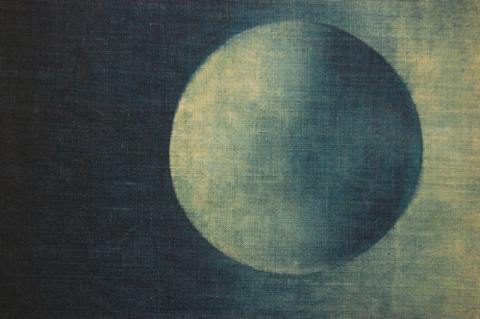74. The "Moon" Radical: 月
The "sun" radical 日 (radical 72) appears in so many kanji that one might expect the same of the "moon" radical 月.

Photo Credit: Glennis Dolce
Reflections on an Indigo Moon, a shibori work
by Glennis Dolce. Shibori, from 絞る (しぼる: to wring),
is a Japanese form of tie-dyeing.
In the kanji world, however, things are not always regular, and that's definitely true of 月. To be sure, this shape appears in scads of kanji, but in most cases it represents "flesh" and is a simplification of 肉. (See Radical Note 130 for more on that.) I can find only four Joyo kanji with a 月 radical that means "moon." Of those four, one is iffy, but these three definitely contain moons:
月 (16: moon, month)
This is a pictograph of a "crescent moon with a pitted surface," says Henshall.
望 (585: hope; to look afar)
Henshall explains that, with a slightly different shape, this originally represented a "person" standing on the "ground," gazing with "wide-open eyes" at the "moon." This behavior went hand in hand with wishful thinking.
朗 (995: clear, fine, cheerful)
Henshall says that the left side means "good" and that a "good moon" is clear. "Bright" and "cheerful" are associated meanings.

Henshall and Kanjigen disagree about the 月 in a fourth Joyo kanji:
期 (251: term; age; era; time limit; to expect, hope for)
According to Henshall, the components were initially organized differently, and 月 (moon) later replaced the original 日 (day, sun). The 其 derives from a component representing a "winnowing device." He notes that as something related to the harvest, winnowing came to symbolize a "cycle of time," leading to the concept of "regular" and "predictable," which is to say "something one can expect." By contrast, Kanjigen asserts that 期 comes from 其 (square, squarely) plus 月 (moon). By waxing and waning, the moon "squarely" returns to its original shape. (A square moon?!) Kanjigen mixes in some talk of the sun, as well, commenting that this kanji could also represent the sun as it returns to its original position through the seasons. Ah, perhaps the moon and sun do work in tandem.
One other character might seem to have a moon but doesn't:
朝 (175: morning; regime, period, epoch)
Henshall says that, etymologically, that's not a "moon" on the right but a "river." Kanjigen agrees with that in terms of the bronze-script version of 朝 but notes that in the later seal-script period, the right-hand component shifted to 舟 (boat), which gave the kanji its sound.

Photo Credit: Glennis Dolce
Tsuki no Ai, a shibori work by Glennis Dolce.
The name in kanji is 「月の藍 (つきのあい: indigo moon)」.
In 月, 望, 朗, 期, and 朝, we can call the radical つき. When this radical appears on the left and means "moon," another possible name is つきへん. But within the Joyo set, there's no such character, or not according to Henshall and Kanjigen. We therefore have to look to the non-Joyo set, where we find a two-moon delight in this word:
朦朧 (もうろう: dim, vague) dim + hazy
This term originally referred to "haziness of the moon." However, when people use 朦朧 conversationally, they're typically referring to their mind or memory as dim or hazy. Looking at that complex word with its 37 strokes, one might easily feel dim!
